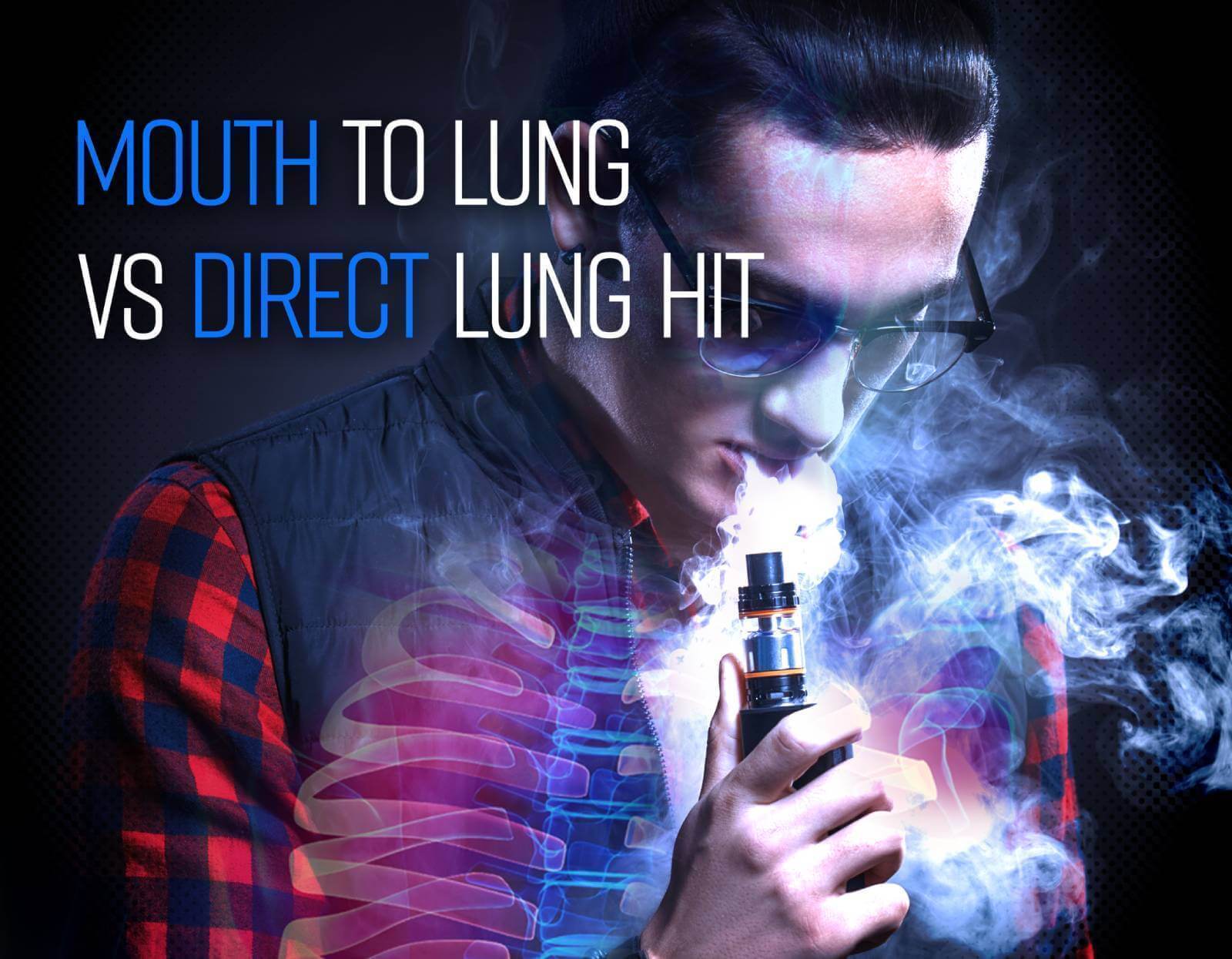WELCOME TO RUTHLESS VAPOR // WELCOME TO RUTHLESS VAPOR // WELCOME TO RUTHLESS VAPOR // WELCOME TO RUTHLESS VAPOR // WELCOME TO RUTHLESS VAPOR // WELCOME TO RUTHLESS VAPOR // WELCOME TO RUTHLESS VAPOR
MTL or DTL: Mouth to Lung vs Direct to Lung
Mouth to lung, or MTL inhale and direct to lung, or DTL, are words you will hear often in the vaping community. But what does MLT and DTL mean exactly?
What Does MTL or Mouth to Lung Inhale Mean?

Mouth to Lung (MTL / ML) means inhaling by filling the mouth with vapor before further inhaling into the lung.
- Similar to the way you puff a cigarette
- Think about drinking through a straw instead of chugging a beer
What is DTL or a Direct to Lung inhale?

Direct Lung Inhale (DLI) / Direct to Lung (DTL) / Direct Lung (DL): Inhaling vapor straight to the lung.
- Think about sucking in air from a balloon
- Another way to think about it is inhaling straight from your lungs instead of your mouth
- Often compared to how you hit a bong or a hookah
Why does MTL or DTL Vaping Matter?
Different methods result in different experiences. Choosing one method over the other is crucial to understand because it will be affected by several factors:
- How you interface with your device
- Airflow setting
- Coil type
- E-juice VG and PG Ratio
- Wattage of battery
Explaining someone the significance of how to inhale seems frivolous as showing someone how to breathe. However, understanding the differences between MTL vape and DTL vape will determine what vaping device you choose as well as what kind of vape juice you will enjoy most.

The MTL Vape Experience
MTL vape devices are recommended to smokers since it mimics the smoking sensation. Before sub-ohm vaping became popular, all vaping devices were MTL to create a smoother transition into vaping.
Here are common characteristics in MTL vaping:
- Low Wattage Devices: Less than 20 watts and are not for cloud chasing, meaning it does not have high cloud production
- Ultra-portable Devices: Due to smaller battery size, devices are pocket-friendly compared to sub-ohm devices and have fewer features such as variable wattage or temperature control
- Tighter Draw: Mouthpiece is narrow and the tighter the draw, the closer it is to a mouth to lung device
- High Resistance Coils: Coils are greater than 1.0 ohm. Coils with high resistance will produce less vapor.
- High Nicotine Strength: More effective with high nicotine strengths such as nicotine salts (25-50 mg) due to lack of vapor production
- Weaker Throat Hit: Less cloud production equals less throat hit. It makes it easier to chain vape.
- More Flavor: MTL vape has high flavor intensity since the vapor lingers in your mouth longer.
Note: throat hit can be adjusted by using higher nicotine strength, higher PG ratio, increasing wattage/temperature, and using specific flavors such as pure menthol
Note: flavor intensity can be fine-tuned by tweaking wattage/temperature settings, reducing airflow for warmer and concentrated vape, types of coil, higher PG ratio, and e-juice quality
Examples of MTL Vaping Devices

Read our different types of vapes article for detailed information on each device!
- Open pod systems
- Closed pod systems
- Cig-a-likes
The DTL Inhale Experience

DTL vape devices have become a popular choice among vapers due to the mainstream adoption of sub-ohm vaping. Mods are known for its power and advanced personalization features.
Here are common characteristics of DTL vaping:
- High Wattage Devices: Increased power equals greater cloud production resulting in higher e-liquid consumption. Tend to use higher VG ratio for smoother throat hit and thicker clouds.
- Larger Devices: Compared to MTL vape devices, DTL devices are larger due to battery size.
- Sub-ohm coils: Coils are less than 1.0 ohm. Coils with lower resistance increase cloud production. DTL devices are not limited to sub-ohm coils and can use higher resistance coils depending on the device.
- Airflow Control: Larger mouthpiece but can adjust airflow to increase/decrease throat hit.
- Intense Throat Hit: Higher wattages create bigger clouds and a warmer vape for a fulfilling throat hit. Throat hit is essential in vaping to replicate the feeling smokers are accustomed to when smoking cigarettes.
- Lower Nicotine Strength: High nicotine strength is not necessary due to an increase in power. DTL vaping requires only 3 - 6 mg of nicotine. Higher than 12 mg nicotine is not recommended.
- Less Flavor: DTL vaping results in less flavor since the vapor goes directly to the lung. The more air flowing through your coils, the vapor density decreases which results in less flavor but more voluminous clouds. However, higher flavor intensity can be achieved by tweaking wattages/temperature settings, restricting airflow, and experimenting with different resistances in coils.
Note: Increase cloud production by using higher VG ratio, lower resistance coils, increasing airflow, and wattage.
Note: Throat hit is adjustable by increasing wattage/temperature for a warmer vape, reducing airflow, vaping higher nicotine strength, and dependent on the flavor of the vape juice.
Examples of DTL Inhale Devices

- Box Mods
- Tube Mods
- Mechanical Mods (Not for beginners)
Mouth to Lung (MTL) vs Direct Lung (DL) Vaping

Mouth To Lung Devices
Pros:
- Less e-juice consumption
- High nicotine strength - subdue nicotine cravings
- Great Flavor- premium e-juice flavors are designed for low wattage devices
- Ultra-portable - convenient to carry around
- Mimics smoking experience - mouth to lung inhale
- Fast Charging
- User-friendly devices - great entry level vaping device
Cons:
- Weaker throat hit - not as satisfying as sub-ohm vaping due to lower wattages and tighter draw
- Shorter battery life - needs to be charged more often
- Fewer features - not able to personalize the experience
Direct Lung Inhale Devices
Pros:
- Appreciable Cloud Production
- Intense Flavor - finding the sweet spot to intensify flavor
- Strong throat hit
- Longer battery life
- Advanced features to personalize your experience
Cons:
- Longer charging time
- Bulky device - not as pocket-friendly as MTL devices
- Longer learning curve to understand the features
- Higher e-juice consumption - requires more refilling
MTL or DTL. Which one works best for you?
MTL devices are often selected by new vapers for three reasons:
- Simplicity - user-friendliness of the device makes a more natural transition from smoking to vaping - check out our vape pods article for more information on MTL devices.
- High Nicotine Strength - experts recommend 50 mg of nicotine for heavy smokers.
- Mouth to lung inhale - resembles the way you inhale a cigarette.
DTL devices allow for greater flexibility but come with a steep learning curve. Here are some reasons you would get a Direct lung inhale device:
- Ideal for cloud chasers and for those who want to play around with the settings to hit the sweet spot for maximum flavor
- Devices with an airflow control and variable wattage can allow you to create a MTL experience.
- Lower nicotine strength is used because of more significant cloud production. More clouds = greater nicotine consumption.
- Read our best starter kit for beginners article for some solid sub-ohm vaping devices!
Different types of vaping devices offer different experiences. It’s up to you to decide what works best for you. Understanding the differences between MTL and DL will guide you in picking the right device!
What MLT or DTL device is your favorite? Comment below. Your input can maybe help someone along in their vape journey.


